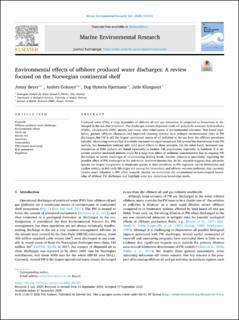| dc.description.abstract | Produced water (PW), a large byproduct of offshore oil and gas extraction, is reinjected to formations or discharged to the sea after treatment. The discharges contain dispersed crude oil, polycyclic aromatic hydrocarbons (PAHs), alkylphenols (APs), metals, and many other constituents of environmental relevance. Risk-based regulation, greener offshore chemicals and improved cleaning systems have reduced environmental risks of PW discharges, but PW is still the largest operational source of oil pollution to the sea from the offshore petroleum industry. Monitoring surveys find detectable exposures in caged mussel and fish several km downstream from PW outfalls, but biomarkers indicate only mild acute effects in these sentinels. On the other hand, increased concentrations of DNA adducts are found repeatedly in benthic fish populations, especially in haddock. It is uncertain whether increased adducts could be a long-term effect of sediment contamination due to ongoing PW discharges, or earlier discharges of oil-containing drilling waste. Another concern is uncertainty regarding the possible effect of PW discharges in the sub-Arctic Southern Barents Sea. So far, research suggests that sub-arctic species are largely comparable to temperate species in their sensitivity to PW exposure. Larval deformities and cardiac toxicity in fish early life stages are among the biomarkers and adverse outcome pathways that currently receive much attention in PW effect research. Herein, we summarize the accumulated ecotoxicological knowledge of offshore PW discharges and highlight some key remaining knowledge needs. | |
